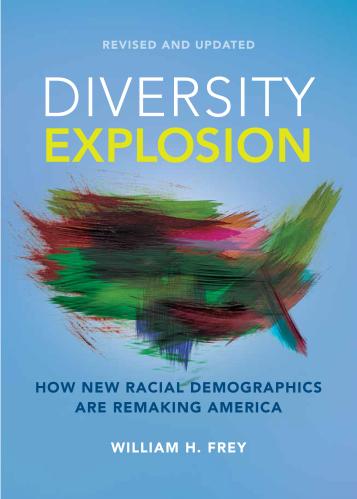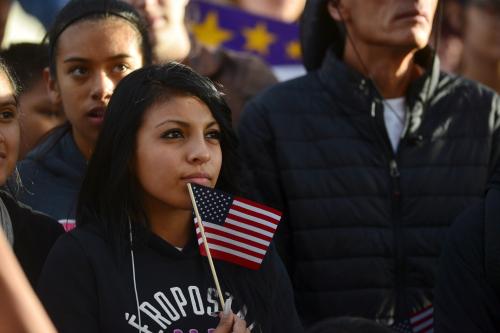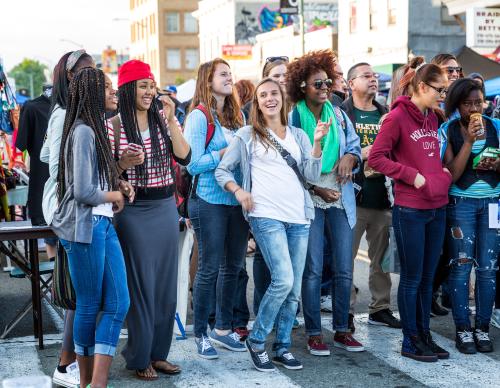Recently, the U.S. Census Bureau released its 2013-2017 American Community Survey five-year estimates. Those data show that black-white neighborhood segregation varies widely across metropolitan areas, and has declined only modestly since the beginning of this century. Most white residents of large metropolitan areas live in neighborhoods that remain overwhelmingly white, and while black neighborhoods have become more diverse, this is largely due to an increase in Hispanic rather than white residents.
Black-white segregation remains high in northern metropolitan areas
Segregation levels between blacks and whites within metropolitan areas were very high through the middle part of the 20th century. After the passage of the 1968 Fair Housing Act, black-white segregation began to decline, especially in growing parts of the country like Atlanta and Dallas to which blacks were relocating, where they faced less housing discrimination than in the past.
By the early 2000s, the highest levels of segregation continued to exist in northern metro areas where black population growth had levelled off and new development was sparse (Table 1). (The segregation index shown here varies from values of 0—complete integration—to 100—complete segregation).[1] Even in 2000, three metro areas had segregation indices exceeding 80, and nine more registered indices over 70. In metro areas like Detroit, Milwaukee, and New York, black populations tended to remain more concentrated in central cities, entrenched residential patterns persisted in contrast to those in growing parts of the South and the West.

By the 2013-2017 period, these areas still ranked among the most segregated, though segregation levels declined in each since 2000. Even so, at least three in four black residents in Milwaukee, New York, and Chicago would need to relocate in order to live in fully integrated neighborhoods with whites. In another four areas—Detroit, Cleveland, Buffalo, and St. Louis—seven in ten blacks would have to relocate to live in a completely integrated neighborhood with whites.
These highly segregated areas, however, do not tell the full story. Black-white segregation levels vary greatly across the 51 major metropolitan areas with populations of at least 1 million, with Las Vegas registering the lowest value at just under 40 (Map 1) (download Table A). In 19 of these areas, segregation values are in the 60s, including a mix of large coastal areas (e.g. Boston, Philadelphia, Washington, D.C., Miami, Los Angeles, and San Francisco) and a smattering of areas in the nation’s interior. In 16 metro areas, segregation values are in the 50s, including Sun Belt growth centers such as Atlanta, Dallas, Tampa, and Charlotte, N.C. The nine areas that exhibit values below 50 include several other Southern migration magnets (e.g., Raleigh, N.C., Austin, Texas, and San Antonio) along with a few Western metros (e.g., Phoenix, Las Vegas, and Riverside, Calif.).

Black-white segregation fell in most metro areas since 2000
Overall, in 45 of these 51 metro areas black-white segregation has declined since 2000. Most only achieved modest reductions of 1 to 4 points. Yet 16 areas did show declines of 5 points or more. Detroit led the way with a decline of nearly 12 points, and other Midwestern and Northern metro areas including Kansas City, Indianapolis, Cincinnati, Chicago, Buffalo, Cleveland, and Minneapolis also posted large drops in segregation. Southern and Western metro areas with marked drops in segregation included Tampa, Fla., Louisville, Ken., Orlando, Fla., Houston, Memphis, Tenn., Atlanta, New Orleans, and Miami. Many of the latter areas registered noticeable black population gains from 2000 to 2017, and in most areas that experienced neighborhood segregation declines, black suburbanization facilitated greater integration.
While modest and widespread segregation decline continues an earlier trend, segregation levels greater than 50, which most areas exhibit, are still high by most standards.
Notwithstanding the significant progress in some metro areas, the average segregation level among these 51 places fell only modestly, from 62.8 in 2000 to 59.4 in 2013-2017. While this modest and widespread segregation decline continues an earlier trend, segregation levels greater than 50, which most areas exhibit, are still high by most standards.
Hispanics are making white and black neighborhoods more racially diverse
Another way to examine shifts in segregation is to look at the racial profiles of neighborhoods where the average white or black resident lives.[2]
In 2013-2017, the average white resident of the nation’s 100 largest metropolitan areas lived in a neighborhood that was 72 percent white. That white share declined from 79 percent in 2000. On average, whites were exposed to less racial diversity than existed in these metropolitan areas overall, which were 64 percent white in 2000 and 55 percent white in 2013-2017. Much of the increase in white exposure to non-whites was attributable to a rise in Hispanic neighbors. The average white resident’s neighborhood was 12.2 percent Hispanic in 2013-17, up from 8.5 percent Hispanic in 2000. There were smaller increases in these neighborhoods for blacks, Asians, and other nonwhite racial groups.
This pattern of increased white exposure to non-white groups was consistent across metropolitan areas. In each of the 51 major metro areas, the average white resident lived in a neighborhood that was less white in 2013-2017 than in 2000 (download Table B). The largest shifts toward more diverse white resident neighborhoods—where the white exposure index dropped at least 10 percentage points—occurred in metro areas with growing Hispanic, black, and Asian populations, including Las Vegas, Orlando, Riverside, Miami, San Jose, Atlanta, Houston, Tampa, and Dallas. Clearly, the increased diversity in white resident neighborhoods is related to the growth and in-migration, metropolitan-wide, of other racial groups.
The overall trend toward greater neighborhood diversity occurred for blacks as well. (Figure 1). The average black resident of the 100 largest metro areas lived in a neighborhood that was 45 percent black in 2013-2017, down from 52 percent in 2000. (Blacks comprised 14 percent of all large metropolitan residents in both years.) Yet the white population share of that neighborhood remained almost exactly the same as in 2000. The increased diversity was mainly attributable to Hispanics, who comprised 17 percent of the average black resident’s neighborhood in 2013-2017, up from 12 percent in 2000.
This trend, too, was fairly pervasive across individual metropolitan areas, particularly in the 10 metro areas with largest black populations (download Table C). In most of these places (except Detroit and Chicago), much of the increased neighborhood diversity for blacks came from increasing numbers of Hispanics and other nonwhite racial groups. In Washington, D.C., for instance, the average black resident’s neighborhood saw its black population share drop from 58 percent to 54 percent, its white population share drop from 28 percent to 25 percent, and its Hispanic population share rise from 8 percent to 12 percent.
This analysis shows that black-white neighborhood segregation continued to decline pervasively, albeit modestly, between 2000 and the mid 2010-2020 decade. Significant regional differences persist in segregation levels and trends, emphasizing the value of a metropolitan view on the dynamics that contribute to—and inhibit—greater racial integration in American society.
1 Segregation levels are measured by the index of dissimilarity, which compares the distribution of blacks across a metropolitan area’s neighborhoods (census tracts) with the distribution of whites across those neighborhoods. Values vary from 0 (complete integration) to 100 (complete segregation) where the value indicates the percentage of blacks that would need to change neighborhoods to be distributed the same as whites.
2 The neighborhood (census tract) racial makeup for the average white (or black) resident in the metropolitan area is the weighted average of racial compositions of all neighborhoods in the metropolitan area, where weights represent the sizes of each neighborhood’s white (or black) population. This measure is sometimes referred to as an “exposure” measure.
The Brookings Institution is committed to quality, independence, and impact.
We are supported by a diverse array of funders. In line with our values and policies, each Brookings publication represents the sole views of its author(s).








Commentary
Black-white segregation edges downward since 2000, census shows
December 17, 2018